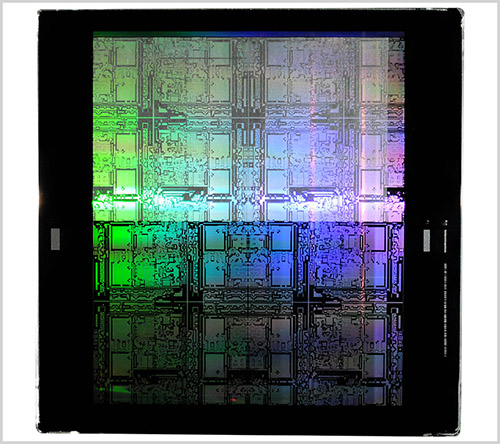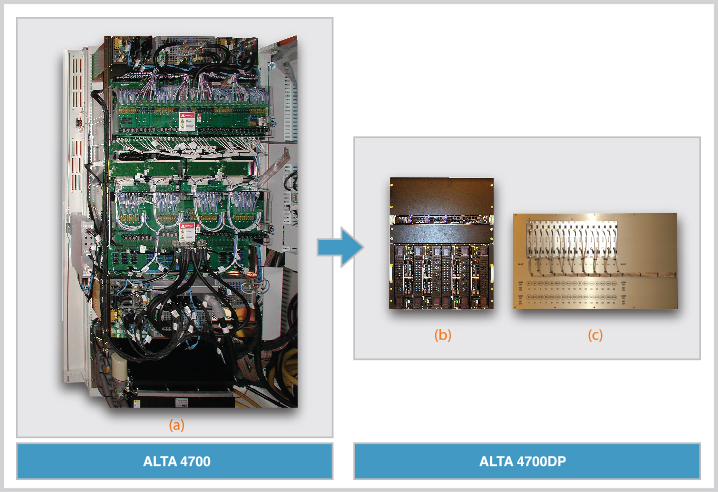Faster Photomask Production with New ALTA™ 4700DP Laser Writer
By Tom Newman
Photomasks—used during photolithography to project circuit patterns onto silicon wafers layer-by-layer—are essential to the production of semiconductors. Recent strong chip demand has led to record revenues in the photomask market, with more than $4 billion projected for 2019.1
Today, more mask layers than ever are required across the entire spectrum of semiconductor technologies. That is particularly true at the most advanced nodes, which may require an unprecedented 80-100 different masks to pattern a device; but it is also true for technologies that are far from the leading edge. A case in point: 200mm production is booming at fabs around the world for automotive, wireless, IoT and other fast-growing IC applications, and is driving significant mask demand.
Merchant mask suppliers and in-house, or “captive,” mask shops alike have struggled to meet the growing need for more masks—and for more complex masks—in a timely manner. Thus, there is an urgent requirement to speed up photomask production and to increase capacity to eliminate a potential bottleneck in device production.
Mask writers based on electron-beam (e-beam) technology are used to pattern critical masks at the most advanced nodes because they can produce smaller features than traditional laser writers, but their writing speeds are relatively slow. Also, they are also costly, energy-intensive and physically large.
Consequently, mask makers prefer to use faster laser-based systems wherever possible, including for all but the most critical masks for advanced devices. Laser writers are also widely used to overlay second level patterns on already-patterned masks, a requirement to produce phase-shifting masks (PSMs) that enhance the process window for wafer lithography.
As laser mask writers are in such widespread use, one strategy to help address the industry’s photomask challenges is to find ways to increase their throughput. In response, Applied Materials is introducing a new software-based data path for the Applied ALTA™ 4700 laser writer, the industry-standard multi-beam deep ultraviolet (DUV) laser patterning tool for both binary masks and PSMs.
The new Applied ALTA 4700DP system is part of a suite of powerful solutions offered for the fabrication and inspection of photomasks, including Sigmameltec™ resist-processing/cleaning products; Centura™ Tetra™ EUV and optical mask etch systems; and the Applied Aera5™ Mask Inspection system. Advanced masks are 6-inches square (figure 1), but masks used for legacy wafer production include several other sizes and are mostly written by the large installed base of ALTA 3000-series laser writers

Figure 1. The mask shown was written by the ALTA 4700DP in four-pass printing mode, and includes a clear field (top), dark field (bottom), and mirrored/unmirrored (right/left) patterns. These data transforms were performed automatically by the ALTA 4700DP data path.
Software Data Path Boosts Throughput
In the new ALTA 4700DP, a highly integrated software-based data path replaces the complex hardware-based data path previously used (figure 2). The software runs on a 128-core array of high speed processors and enables the tool to pattern masks 10% to 50% faster than before.

Figure 2. The complex hardware-based data path in Applied’s ALTA 4700 laser writer (a) has been replaced by a streamlined, more powerful and highly integrated software-based data path in the new ALTA 4700DP (b, c). The Raster Engine (b) runs data preparation and rasterization in parallel, and the Beam Engine (c) modulates the intensity of the 32 beams.
The new system takes mask design data residing in the familiar, commonly used MEBES™ or OASIS™ formats, prepares the data for faster processing by converting it to a specialized internal format, and then rasterizes it. The resulting output is then used to generate multiple RF signals which precisely drive the system’s DUV laser beams to pattern a mask. Both the data preparation and rasterization functions take place up to ten times faster with the new data path, depending on pattern complexity.
By eliminating data path overhead time, the ALTA 4700DP prints at its highest possible speed for the great majority of mask patterns. Performance benchmarking indicates that even sparse test patterns print about 10% faster, while dense production patterns print up to 50% faster (figure 3). All this enables the ALTA 4700DP to deliver faster write times in both two- and four-pass modes.

Figure 3. Masks print about 10% faster for sparse test patterns (e.g., Jobs 2 and 3), and 40% to 50% faster for dense production patterns (e.g., Jobs 6 and 7).
In addition, the new data path can compensate for CD (critical dimension) errors related to variations in process signatures and pattern density across a mask. It also offers greater repeatability than before in printing pattern corners, with a 4x reduction in corner radius variation.
Designed to Evolve with User Needs
The ALTA 4700DP is designed from the outset to be readily updated and modified to meet future user requirements, with a Raster Engine based on industry-standard EDA software; open-source Linux operating system technology; and incorporation of the industry-standard OASIS patterning language to complement Applied’s own MEBES format.
The ALTA 4700DP also conforms to the SECS/GEM standard for high-speed data communications between tools and the fab host, so that the mask-writing process can be automated.
The new software data path is powered by a scalable 128-core array of powerful but off-the-shelf processors that execute code in parallel, which enables the ALTA 4700DP to handle much denser patterns than before without obstruction. This new architecture also offers greater stability, availability and serviceability than was possible with the custom circuitry at the heart of the previous data path.
Commitment to Industry Problem-Solving
In semiconductor manufacturing, time is money. The industry urgently needs to find ways to produce more photomasks more quickly, and the new ALTA 4700DP with its faster writing, higher availability and modernized architecture is a significant step forward. It is a part of Applied Materials’ ongoing development of technologies to serve current and future needs in photomask production.
For more information, please contact tom_newman@amat.com
[1]http://info.semi.org/photomask-market-forecast-to-exceed-4.0b-in-2019?ec...
